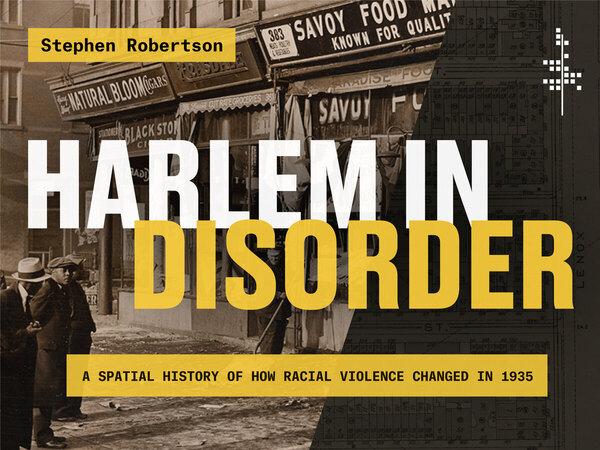
Available in March
ISBN: 9781503630451
The violence that spread across Harlem on the night of March 19, 1935 was the first large-scale racial disorder in the United States in more than a decade and the first occurrence in the nation's leading Black neighborhood. However, as many observers pointed out, the events were "not a race riot" of the kind that had marked the decades after the Civil War. Racial violence took a new form in 1935.
Through a granular analysis of those events and the mapping of their locations, Harlem in Disorder reveals that Harlem's residents participated in a complex new mix of violence that was a multifaceted challenge to white economic and political power. Tracing the legal and government investigations that followed, this project highlights how that violence came to be distorted, diminished, and marginalized by the concern of white authorities to maintain the racial order, and by the unwillingness of Harlem's Black leaders and their white allies to embrace fully such direct forms of protest.
Focused on capturing rather than simplifying the complexity of the new form of racial violence, Harlem in Disorder is a multilayered, hyperlinked narrative that connects different scales of analysis: individual events, aggregated patterns, and a chronological narrative. Its structure foregrounds individual events to counter how data can dehumanize the past, and to make transparent the interpretations involved in the creation of data from uncertain and ambiguous sources.
About the author
Stephen Robertson is Professor of History at George Mason University.
"Harlem in Disorder is a remarkable achievement. It embodies the promise of digital humanities, creating a deeply immersive and analytically rich history of a milestone event in the history of New York City and 1930s America. Robertson achieves an enviable balance by bringing clarity to the 1935 Harlem Riot without diminishing the complexity of the motives of its participants, officials, and commentators. All future works on American collective violence and urban unrest will need to take into account this book's findings and Robertson's exemplary scholarship."
—W. Fitzhugh Brundage, University of North Carolina
"Harlem in Disorder gives new meaning to the idea of a deep dive. The work is a model for anyone planning to do a digital history project, and a powerful answer for those who still wonder what value digital history has."
—Elizabeth Dale, University of Florida
"Harlem in Disorder is a landmark in digital scholarship. Integrating remarkable research, innovative strategies, and compelling narrative, this work demonstrates new dimensions of historical understanding. Stephen Robertson portrays individuals and their complex humanity in a way never before possible."
—Edward Ayers, Recipient of the National Humanities Medal
"Harlem in Disorder evenhandedly unfolds the events of March 1935 in half-hour segments, allowing us to envision what actually occurred. Robertson comprehensively reconstructs the disorder and its later representations in the media, courts, investigations, and culture—an unprecedented accomplishment."
—Amanda I. Seligman, University of Wisconsin, Milwaukee